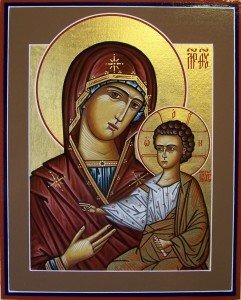 In the last several issues of this article, I presented concrete ideas about Sacred Tradition. The first idea I presented was that Sacred Tradition includes the faith set-forth in the Seven Ecumenical Councils which serve as the RUDDER for our Church. The two weeks that followed my presentation on the Councils of the Church, were devoted to two of the major feasts of our Church, the Transfiguration of Our Lord and the Dormition of the Mother of God. The feasts of the Church flow directly from Sacred Tradition. These are but two of the 12 major feasts in our Church – 8 celebrating events in the life of Christ and 4 celebrating events in the life of Mary, the Mother of God.
In the last several issues of this article, I presented concrete ideas about Sacred Tradition. The first idea I presented was that Sacred Tradition includes the faith set-forth in the Seven Ecumenical Councils which serve as the RUDDER for our Church. The two weeks that followed my presentation on the Councils of the Church, were devoted to two of the major feasts of our Church, the Transfiguration of Our Lord and the Dormition of the Mother of God. The feasts of the Church flow directly from Sacred Tradition. These are but two of the 12 major feasts in our Church – 8 celebrating events in the life of Christ and 4 celebrating events in the life of Mary, the Mother of God.
These twelve major feasts were developed over the first seven centuries of the Church and integrated into our yearly, liturgical calendar. As one author (i.e., Rudolph) maintains, the original purpose of these feasts was not to commemorate events in Christ’s life but rather to put forth theological and ultimately political propositions in an accessible and convincing form. These feasts truly amplify our understanding of our faith. They are a part of Sacred Tradition. The services that have been composed to celebrate these feasts present a great deal of our theology.
Many of the modern Western Christian denominations have eliminated all of but two of these feasts. They disregard the more than seven centuries that the Church spent developing these feasts and the prayers that are used to celebrate them.
Our Church maintains these twelve feasts because they have been handed down to us and preserved by the Sacred Tradition of the Church. To disregard these feasts means to disregard a great portion of the history of Christianity. To celebrate them places us in the mainstream of Christian history.
So we see that two main streams of Sacred Tradition are the statements formulated by the Church during the first eight centuries in the foundational Councils AND the liturgical life of the Church which is amplified by the inclusion of not only twelve major feasts but also a whole calendar of commemorations of various persons (i.e., saints) who have showed us how to live our faith.
There are yet other elements to Sacred Tradition which I shall share in the coming weeks.
